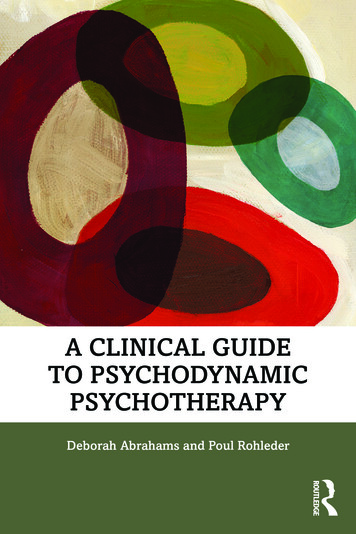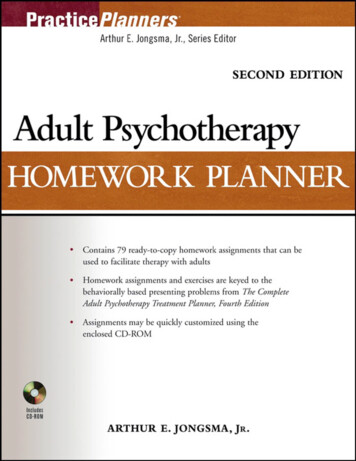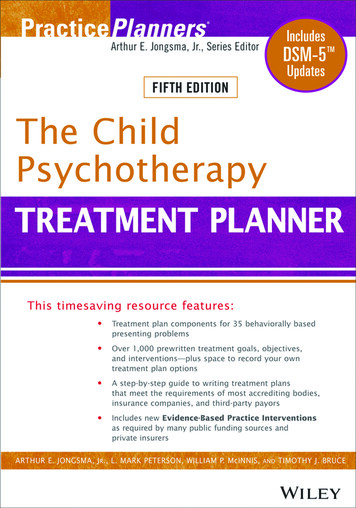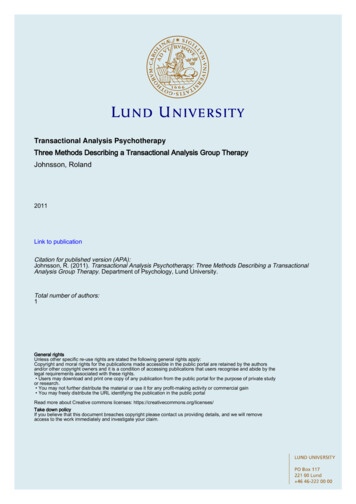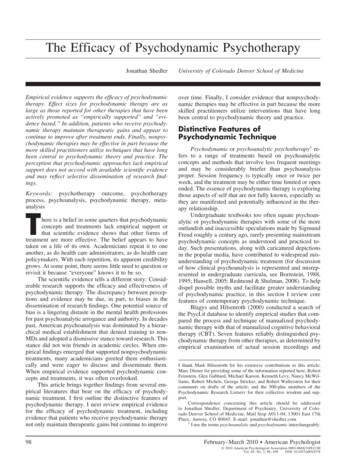
Transcription
The Efficacy of Psychodynamic PsychotherapyJonathan ShedlerEmpirical evidence supports the efficacy of psychodynamictherapy. Effect sizes for psychodynamic therapy are aslarge as those reported for other therapies that have beenactively promoted as “empirically supported” and “evidence based.” In addition, patients who receive psychodynamic therapy maintain therapeutic gains and appear tocontinue to improve after treatment ends. Finally, nonpsychodynamic therapies may be effective in part because themore skilled practitioners utilize techniques that have longbeen central to psychodynamic theory and practice. Theperception that psychodynamic approaches lack empiricalsupport does not accord with available scientific evidenceand may reflect selective dissemination of research findings.Keywords: psychotherapy outcome, psychotherapyprocess, psychoanalysis, psychodynamic therapy, metaanalysisThere is a belief in some quarters that psychodynamicconcepts and treatments lack empirical support orthat scientific evidence shows that other forms oftreatment are more effective. The belief appears to havetaken on a life of its own. Academicians repeat it to oneanother, as do health care administrators, as do health carepolicymakers. With each repetition, its apparent credibilitygrows. At some point, there seems little need to question orrevisit it because “everyone” knows it to be so.The scientific evidence tells a different story: Considerable research supports the efficacy and effectiveness ofpsychodynamic therapy. The discrepancy between perceptions and evidence may be due, in part, to biases in thedissemination of research findings. One potential source ofbias is a lingering distaste in the mental health professionsfor past psychoanalytic arrogance and authority. In decadespast, American psychoanalysis was dominated by a hierarchical medical establishment that denied training to nonMDs and adopted a dismissive stance toward research. Thisstance did not win friends in academic circles. When empirical findings emerged that supported nonpsychodynamictreatments, many academicians greeted them enthusiastically and were eager to discuss and disseminate them.When empirical evidence supported psychodynamic concepts and treatments, it was often overlooked.This article brings together findings from several empirical literatures that bear on the efficacy of psychodynamic treatment. I first outline the distinctive features ofpsychodynamic therapy. I next review empirical evidencefor the efficacy of psychodynamic treatment, includingevidence that patients who receive psychodynamic therapynot only maintain therapeutic gains but continue to improve98University of Colorado Denver School of Medicineover time. Finally, I consider evidence that nonpsychodynamic therapies may be effective in part because the moreskilled practitioners utilize interventions that have longbeen central to psychodynamic theory and practice.Distinctive Features ofPsychodynamic TechniquePsychodynamic or psychoanalytic psychotherapy1 refers to a range of treatments based on psychoanalyticconcepts and methods that involve less frequent meetingsand may be considerably briefer than psychoanalysisproper. Session frequency is typically once or twice perweek, and the treatment may be either time limited or openended. The essence of psychodynamic therapy is exploringthose aspects of self that are not fully known, especially asthey are manifested and potentially influenced in the therapy relationship.Undergraduate textbooks too often equate psychoanalytic or psychodynamic therapies with some of the moreoutlandish and inaccessible speculations made by SigmundFreud roughly a century ago, rarely presenting mainstreampsychodynamic concepts as understood and practiced today. Such presentations, along with caricatured depictionsin the popular media, have contributed to widespread misunderstanding of psychodynamic treatment (for discussionof how clinical psychoanalysis is represented and misrepresented in undergraduate curricula, see Bornstein, 1988,1995; Hansell, 2005; Redmond & Shulman, 2008). To helpdispel possible myths and facilitate greater understandingof psychodynamic practice, in this section I review corefeatures of contemporary psychodynamic technique.Blagys and Hilsenroth (2000) conducted a search ofthe PsycLit database to identify empirical studies that compared the process and technique of manualized psychodynamic therapy with that of manualized cognitive behavioraltherapy (CBT). Seven features reliably distinguished psychodynamic therapy from other therapies, as determined byempirical examination of actual session recordings andI thank Mark Hilsenroth for his extensive contributions to this article;Marc Diener for providing some of the information reported here; RobertFeinstein, Glen Gabbard, Michael Karson, Kenneth Levy, Nancy McWilliams, Robert Michels, George Stricker, and Robert Wallerstein for theircomments on drafts of the article; and the 500-plus members of thePsychodynamic Research Listserv for their collective wisdom and support.Correspondence concerning this article should be addressedto Jonathan Shedler, Department of Psychiatry, University of Colorado Denver School of Medicine, Mail Stop A011-04, 13001 East 17thPlace, Aurora, CO 80045. E-mail: jonathan@shedler.com1I use the terms psychoanalytic and psychodynamic interchangeably.February–March 2010 American Psychologist 2010 American Psychological Association 0003-066X/10/ 12.00Vol. 65, No. 2, 98 –109DOI: 10.1037/a0018378
JonathanShedlertranscripts (note that the features listed below concernprocess and technique only, not underlying principles thatinform these techniques; for a discussion of concepts andprinciples, see Gabbard, 2004; McWilliams, 2004; Shedler,2006a):1. Focus on affect and expression of emotion. Psychodynamic therapy encourages explorationand discussion of the full range of a patient’s emotions. Thetherapist helps the patient describe and put words to feelings, including contradictory feelings, feelings that aretroubling or threatening, and feelings that the patient maynot initially be able to recognize or acknowledge (thisstands in contrast to a cognitive focus, where the greateremphasis is on thoughts and beliefs; Blagys & Hilsenroth,2002; Burum & Goldfried, 2007). There is also a recognition that intellectual insight is not the same as emotionalinsight, which resonates at a deep level and leads to change(this is one reason why many intelligent and psychologically minded people can explain the reasons for their difficulties, yet their understanding does not help them overcome those difficulties).2. Exploration of attempts to avoid distressing thoughts and feelings. People do a greatmany things, knowingly and unknowingly, to avoid aspectsof experience that are troubling. This avoidance (in theoretical terms, defense and resistance) may take coarseforms, such as missing sessions, arriving late, or beingevasive. It may take subtle forms that are difficult torecognize in ordinary social discourse, such as subtle shiftsof topic when certain ideas arise, focusing on incidentalaspects of an experience rather than on what is psychologically meaningful, attending to facts and events to theexclusion of affect, focusing on external circumstancesrather than one’s own role in shaping events, and so on.February–March 2010 American PsychologistPsychodynamic therapists actively focus on and exploreavoidances.3. Identification of recurring themes andpatterns. Psychodynamic therapists work to identifyand explore recurring themes and patterns in patients’thoughts, feelings, self-concept, relationships, and life experiences. In some cases, a patient may be acutely aware ofrecurring patterns that are painful or self-defeating but feelunable to escape them (e.g., a man who repeatedly findshimself drawn to romantic partners who are emotionallyunavailable; a woman who regularly sabotages herselfwhen success is at hand). In other cases, the patient may beunaware of the patterns until the therapist helps him or herrecognize and understand them.4. Discussion of past experience (developmental focus). Related to the identification of recurring themes and patterns is the recognition that past experience, especially early experiences of attachment figures,affects our relation to, and experience of, the present.Psychodynamic therapists explore early experiences, therelation between past and present, and the ways in whichthe past tends to “live on” in the present. The focus is noton the past for its own sake, but rather on how the pastsheds light on current psychological difficulties. The goal isto help patients free themselves from the bonds of pastexperience in order to live more fully in the present.5. Focus on interpersonal relations. Psychodynamic therapy places heavy emphasis on patients’relationships and interpersonal experience (in theoreticalterms, object relations and attachment). Both adaptive andnonadaptive aspects of personality and self-concept areforged in the context of attachment relationships, and psychological difficulties often arise when problematic interpersonal patterns interfere with a person’s ability to meetemotional needs.6. Focus on the therapy relationship. Therelationship between therapist and patient is itself an important interpersonal relationship, one that can becomedeeply meaningful and emotionally charged. To the extentthat there are repetitive themes in a person’s relationshipsand manner of interacting, these themes tend to emerge insome form in the therapy relationship. For example, aperson prone to distrust others may view the therapist withsuspicion; a person who fears disapproval, rejection, orabandonment may fear rejection by the therapist, whetherknowingly or unknowingly; a person who struggles withanger and hostility may struggle with anger toward thetherapist; and so on (these are relatively crude examples;the repetition of interpersonal themes in the therapy relationship is often more complex and subtle than these examples suggest). The recurrence of interpersonal themes inthe therapy relationship (in theoretical terms, transferenceand countertransference) provides a unique opportunity toexplore and rework them in vivo. The goal is greaterflexibility in interpersonal relationships and an enhancedcapacity to meet interpersonal needs.7. Exploration of fantasy life. In contrast toother therapies in which the therapist may actively structuresessions or follow a predetermined agenda, psychodynamic99
therapy encourages patients to speak freely about whateveris on their minds. When patients do this (and most patientsrequire considerable help from the therapist before they cantruly speak freely), their thoughts naturally range overmany areas of mental life, including desires, fears, fantasies, dreams, and daydreams (which in many cases thepatient has not previously attempted to put into words). Allof this material is a rich source of information about howthe person views self and others, interprets and makessense of experience, avoids aspects of experience, or interferes with a potential capacity to find greater enjoymentand meaning in life.The last sentence hints at a larger goal that is implicitin all of the others: The goals of psychodynamic therapyinclude, but extend beyond, symptom remission. Successful treatment should not only relieve symptoms (i.e., get ridof something) but also foster the positive presence ofpsychological capacities and resources. Depending on theperson and the circumstances, these might include thecapacity to have more fulfilling relationships, make moreeffective use of one’s talents and abilities, maintain arealistically based sense of self-esteem, tolerate a widerrange of affect, have more satisfying sexual experiences,understand self and others in more nuanced and sophisticated ways, and face life’s challenges with greater freedomand flexibility. Such ends are pursued through a process ofself-reflection, self-exploration, and self-discovery thattakes place in the context of a safe and deeply authenticrelationship between therapist and patient. (For a jargonfree introduction to contemporary psychodynamic thought,see That Was Then, This Is Now: Psychoanalytic Psychotherapy for the Rest of Us [Shedler, 2006a, which is freelyavailable for download at http://psychsystems.net/shedler.html]).How Effective Is Psychotherapy inGeneral?In psychology and in medicine more generally, meta-analysis is a widely accepted method for summarizing andsynthesizing the findings of independent studies (Lipsey &Wilson, 2001; Rosenthal, 1991; Rosenthal & DiMatteo,2001). Meta-analysis makes the results of different studiescomparable by converting findings into a common metric,allowing findings to be aggregated or pooled across studies.A widely used metric is effect size, which is the differencebetween treatment and control groups, expressed in standard deviation units.2 An effect size of 1.0 means that theaverage treated patient is one standard deviation healthieron the normal distribution or bell curve than the averageuntreated patient. An effect size of 0.8 is considered a largeeffect in psychological and medical research, an effect sizeof 0.5 is considered a moderate effect, and an effect size of0.2 is considered a small effect (Cohen, 1988).The first major meta-analysis of psychotherapy outcome studies included 475 studies and yielded an overalleffect size (various diagnoses and treatments) of 0.85 forpatients who received psychotherapy compared with untreated controls (Smith, Glass, & Miller, 1980). Subsequent100meta-analyses have similarly supported the efficacy of psychotherapy. The influential review by Lipsey and Wilson(1993) tabulated results for 18 meta-analyses concernedwith general psychotherapy outcomes, which had a medianeffect size of 0.75. It also tabulated results for 23 metaanalyses concerned with outcomes in CBT and behaviormodification, which had a median effect size of 0.62. Ameta-analysis by Robinson, Berman, and Neimeyer (1990)summarized the findings of 37 psychotherapy studies concerned specifically with outcomes in the treatment of depression, which had an overall effect size of 0.73. These arerelatively large effects. (For a review of psychotherapyefficacy and effectiveness research, see Lambert & Ogles,2004).To provide some points of reference, it is instructiveto consider effect sizes for antidepressant medications. Ananalysis of U.S. Food and Drug Adminstration (FDA)databases (published and unpublished studies) reported inthe New England Journal of Medicine found effect sizes of0.26 for fluoxetine (Prozac), 0.26 for sertraline (Zoloft),0.24 for citalopram (Celexa), 0.31 for escitalopram (Lexapro), and 0.30 for duloxetine (Cymbalta). The overall meaneffect size for antidepressant medications approved by theFDA between 1987 and 2004 was 0.31 (Turner, Matthews,Linardatos, Tell, & Rosenthal, 2008).3 A meta-analysisreported in the prestigious Cochrane Library (Moncrieff,Wessely, & Hardy, 2004) found an effect size of 0.17 fortricyclic antidepressants compared with active placebo (anactive placebo mimics the side effects of an antidepressantdrug but is not itself an antidepressant).4 These are relatively small effects. Methodological differences betweenmedication trials and psychotherapy trials are sufficientlygreat that effect sizes may not be directly comparable, andthe findings should not be interpreted as conclusive evidence that psychotherapy is more effective. Effect sizes forantidepressant medications are reported to provide reference points that will be familiar to many readers (for morecomprehensive listings of effect size reference points, see,e.g., Lipsey & Wilson, 1993; Meyer et al., 2001).2This score, known as the standardized mean difference, is used tosummarize the findings of randomized control trials. More broadly, theconcept effect size may refer to any measure that expresses the magnitudeof a research finding (Rosenthal & Rosnow, 2008).3The measure of effect size in this study was Hedges’ g (Hedges,1982) rather than Cohen’s d (Cohen, 1988), which is more commonlyreported. The two measures are based on slightly different computational formulas, but in this case the choice of formula would havemade no difference: “Because of the large sample size (over 12,000),there is no change in going from g to d; both values are .31 to twodecimal places” (R. Rosenthal, personal communication to Marc Diener, January 2008).4Although antidepressant trials are intended to be double-blind, theblind is easily penetrated because the adverse side effects of antidepressant medications are physically discernible and widely known. Studyparticipants and their doctors can therefore figure out whether they arereceiving medication or placebo, and effects attributed to medication maybe inflated by expectancy and demand effects. Use of “active” placebosbetter protects the blind, and the resulting effect sizes are approximatelyhalf as large as those otherwise reported.February–March 2010 American Psychologist
How Effective Is PsychodynamicTherapy?A recent and especially methodologically rigorous metaanalysis of psychodynamic therapy, published by theCochrane Library,5 included 23 randomized controlledtrials of 1,431 patients (Abbass, Hancock, Henderson, &Kisely, 2006). The studies compared patients with arange of common mental disorders6 who received shortterm (! 40 hours) psychodynamic therapy with controls(wait list, minimal treatment, or “treatment as usual”)and yielded an overall effect size of 0.97 for generalsymptom improvement. The effect size increased to 1.51when the patients were assessed at long-term follow-up(" 9 months posttreatment). In addition to change ingeneral symptoms, the meta-analysis reported an effectsize of 0.81 for change in somatic symptoms, whichincreased to 2.21 at long-term follow-up; an effect sizeof 1.08 for change in anxiety ratings, which increased to1.35 at follow-up; and an effect size of 0.59 for changein depressive symptoms, which increased to 0.98 atfollow-up.7 The consistent trend toward larger effectsizes at follow-up suggests that psychodynamic therapysets in motion psychological processes that lead to ongoing change, even after therapy has ended.A meta-analysis published in Archives of General Psychiatry included 17 high-quality randomized controlled trialsof short-term (average of 21 sessions) psychodynamic therapyand reported an effect size of 1.17 for psychodynamic therapycompared with controls (Leichsenring, Rabung, & Leibing,2004). The pretreatment to posttreatment effect size was 1.39,which increased to 1.57 at long-term follow-up, which occurred an average of 13 months posttreatment. Translatingthese effect sizes into percentage terms, the authors noted thatpatients treated with psychodynamic therapy were “better offwith regard to their target problems than 92% of the patientsbefore therapy” (Leichsenring et al., 2004, p. 1213).A newly released meta-analysis examined the efficacyof short-term psychodynamic therapy for somatic disorders(Abbass, Kisely, & Kroenke, 2009). It included 23 studiesinvolving 1,870 patients who suffered from a wide range ofsomatic conditions (e.g., dermatological, neurological, cardiovascular, respiratory, gastrointestinal, musculoskeletal,genitourinary, immunological). The study reported effectsizes of 0.69 for improvement in general psychiatric symptoms and 0.59 for improvement in somatic symptoms.Among studies that reported data on health care utilization,77.8% reported reductions in health care utilization thatwere due to psychodynamic therapy—a finding with potentially enormous implications for health care reform.A meta-analysis reported in the American Journal ofPsychiatry examined the efficacy of both psychodynamicpsychotherapy (14 studies) and CBT (11 studies) for personality disorders (Leichsenring & Leibing, 2003). The metaanalysis reported pretreatment to posttreatment effect sizesusing the longest term follow-up available. For psychodynamic therapy (mean length of treatment was 37 weeks), themean follow-up period was 1.5 years and the pretreatment toposttreatment effect size was 1.46. For CBT (mean length ofFebruary–March 2010 American Psychologisttreatment was 16 weeks), the mean follow-up period was 13weeks and the effect size was 1.0. The authors concluded thatboth treatments demonstrated effectiveness. A more recentreview of short-term (average of 30.7 sessions) psychodynamic therapy for personality disorders included data fromseven randomized controlled trials (Messer & Abbass, inpress). The study assessed outcome at the longest follow-upperiod available (an average of 18.9 months posttreatment)and reported effect sizes of 0.91 for general symptom improvement (N # 7 studies) and 0.97 for improvement ininterpersonal functioning (N # 4 studies).Two recent studies examined the efficacy of longterm psychodynamic treatment. A meta-analysis reported in the Journal of the American Medical Association (Leichsenring & Rabung, 2008) compared longterm psychodynamic therapy (" 1 year or 50 sessions)with shorter term therapies for the treatment of complexmental disorders (defined as multiple or chronic mentaldisorders, or personality disorders) and yielded an effectsize of 1.8 for overall outcome.8 The pretreatment toposttreatment effect size was 1.03 for overall outcome,which increased to 1.25 at long-term follow-up (p !.01), an average of 23 months posttreatment. Effect sizesincreased from treatment completion to follow-up for allfive outcome domains assessed in the study (overalleffectiveness, target problems, psychiatric symptoms,personality functioning, and social functioning). A second meta-analysis, reported in the Harvard Review ofPsychiatry (de Maat, de Jonghe, Schoevers, & Dekker,2009), examined the effectiveness of long-term psychodynamic therapy (average of 150 sessions) for adultoutpatients with a range of diagnoses. For patients withmixed/moderate pathology, the pretreatment to posttreatment effect was 0.78 for general symptom improvement,which increased to 0.94 at long-term follow-up, an average of3.2 years posttreatment. For patients with severe personalitypathology, the pretreatment to posttreatment effect was 0.94,which increased to 1.02 at long-term follow-up, an average of5.2 years posttreatment.These meta-analyses represent the most recent andmethodologically rigorous evaluations of psychodynamic therapy. Especially noteworthy is the recurringfinding that the benefits of psychodynamic therapy not only5More widely known in medicine than in psychology, the CochraneLibrary was created to promote evidence based practice and is considereda leader in methodological rigor for meta-analysis.6These included nonpsychotic symptom and behavior disorderscommonly seen in primary care and psychiatric services, for example,nonbipolar depressive disorders, anxiety disorders, and somatoform disorders, often mixed with interpersonal or personality disorders (Abbass etal., 2006).7The meta-analysis computed effect sizes in a variety of ways. Thefindings reported here are based on the single method that seemed mostconceptually and statistically meaningful (in this case, a random effectsmodel, with a single outlier excluded). See the original source for morefine-grained analyses (Abbass et al., 2006).8The atypical method used to compute this effect size may providean inflated estimate of efficacy, and the effect size may not be comparableto other effect sizes reported in this review (for discussion, see Thombs,Bassel, & Jewett, 2009).101
Table 1Illustrative Effect Sizes From Meta-Analyses of Treatment Outcome StudiesTreatment type and referenceGeneral psychotherapySmith et al. (1980)Lipsey & Wilson (1993)Robinson et al. (1990)CBT and related therapiesLipsey & Wilson (1993)Haby et al. (2006)Churchill et al. (2001)Cuijpers et al. (2007)Öst (2008)Antidepressant medicationTurner et al. (2008)Moncrieff et al. (2004)Psychodynamic therapyAbbass et al. (2006)Leichsenring et al. (2004)Anderson & Lambert (1995)Abbass et al. (2009)Messer & Abbass (in press)Leichsenring & Leibing (2003)Leichsenring & Rabung (2008)de Maat et al. (2009)Effect sizeN of studies ormeta-analysesVarious therapies and disordersVarious therapies and disordersVarious therapies for depression0.850.75a0.73475 studies18 meta-analyses37 studiesCBT and behavior therapy, various disordersCBT for depression, panic, and generalizedanxietyCBT for depressionBehavioral activation for depressionDialectical behavior therapy, primarily forborderline personality disorder0.62b0.6823 meta-analyses33 studies1.00.870.5820 studies16 studies13 studiesFDA-registered studies of antidepressantsapproved between 1987 and 2004Tricyclic antidepressants versus active placebo0.3174 studies0.179 studiesVarious disorders, general symptom improvementVarious disorders, change in target problemsVarious disorders and outcomesSomatic disorders, change in general psychiatricsymptomsPersonality disorders, general symptomimprovementPersonality disorders, pretreatment toposttreatmentLong-term psychodynamic therapy vs. shorter termtherapies for complex mental disorders, overalloutcomeLong-term psychoanalytic therapy, pretreatment toposttreatment0.971.170.850.6912 studies7 studies9 studies8 studies0.917 studies1.46c14 studiesDescriptionaMedian effect size across 18 meta-analyses (from Lipsey & Wilson, 1993, Table 1.1).Table 1.2). c Pretreatment to posttreatment (within-group) comparison.endure but increase with time, a finding that has nowemerged from at least five independent meta-analyses (Abbass et al., 2006; Anderson & Lambert, 1995; de Maat etal., 2009; Leichsenring & Rabung, 2008; Leichsenring etal., 2004). In contrast, the benefits of other (nonpsychodynamic) empirically supported therapies tend to decay overtime for the most common disorders (e.g., depression,generalized anxiety; de Maat, Dekker, Schoevers, & deJonghe, 2006; Gloaguen, Cottraux, Cucharet, & Blackburn,1998; Hollon et al., 2005; Westen, Novotny, & ThompsonBrenner, 2004).9Table 1 summarizes the meta-analytic findings described above and adds additional findings to provide further points of reference. Except as noted, effect sizes listedin the table are based on comparisons of treatment andcontrol groups and reflect response at the completion oftreatment (not long-term follow-up).102b1.80.78c7 studies10 studiesMedian effect size across 23 meta-analyses (from Lipsey & Wilson, 1993,Studies supporting the efficacy of psychodynamic therapy span a range of conditions and populations. Randomizedcontrolled trials support the efficacy of psychodynamic therapy for depression, anxiety, panic, somatoform disorders,eating disorders, substance-related disorders, and personalitydisorders (Leichsenring, 2005; Milrod et al., 2007).Findings concerning personality disorders are particularly intriguing. A recent study of patients with borderlinepersonality disorder (Clarkin, Levy, Lenzenweger, & Kernberg, 2007) not only demonstrated treatment benefits thatequaled or exceeded those of another evidence-based treatment, dialectical behavior therapy (Linehan, 1993), but9The exceptions to this pattern are specific anxiety conditions such aspanic disorder and simple phobia, for which short-term, manualized treatments do appear to have lasting benefits (Westen et al., 2004).February–March 2010 American Psychologist
also showed changes in underlying psychological mechanisms (intrapsychic processes) believed to mediate symptom change in borderline patients (specifically, changes inreflective function and attachment organization; Levy et al.,2006). These intrapsychic changes occurred in patientswho received psychodynamic therapy but not in patientswho received dialectical behavior therapy.Such intrapsychic changes may account for long-termtreatment benefits. A newly released study showed enduring benefits of psychodynamic therapy five years aftertreatment completion (and eight years after treatment initiation). At five-year follow-up, 87% of patients who received “treatment as usual” continued to meet diagnosticcriteria for borderline personality disorder, compared with13% of patients who received psychodynamic therapy(Bateman & Fonagy, 2008). No other treatment for personality pathology has shown such enduring benefits.These last findings must be tempered with the caveatthat they rest on two studies and therefore cannot carry asmuch evidential weight as findings replicated in multiplestudies conducted by independent research teams. Moregenerally, it must be acknowledged that there are far moreempirical outcome studies of other treatments, notablyCBT, than of psychodynamic treatments. The discrepancyin sheer numbers of studies is traceable, in part, to theindifference to empirical research of earlier generations ofpsychoanalysts, a failing that continues to haunt the fieldand that contemporary investigators labor to address.A second caveat is that many psychodynamic outcomestudies have included patients with a range of symptomsand conditions rather than focusing on specific diagnosticcategories (e.g., those defined by diagnostic criteria specified in the Diagnostic and Statistical Manual of MentalDisorders [4th edition, DSM-IV; American Psychiatric Association, 1994]). The extent to which this is a limitation isopen to debate. A concern often raised about psychotherapy efficacy studies is that they use highly selected andunrepresentative patient samples and, consequently, thattheir findings do not generalize to real-world clinical practice (e.g., Westen et al., 2004). Nor is there universalagreement that DSM–IV diagnostic categories define discrete or homogeneous patient groups (given that psychiatric comorbidity is the norm and that diagnosable complaints are often embedded in personality syndromes; Blatt& Zuroff, 2005; Westen, Gabbard, & Blagov, 2006). Bethat as it may, an increasing number of studie
The Efficacy of Psychodynamic Psychotherapy Jonathan Shedler University of Colorado Denver School of Medicine Empirical evidence supports the efÞcacy of psychodynamic therapy. Effect sizes for psychodynamic therapy are as large as those reported for other therapies that have been actively promoted as Òempirically supportedÓ and Òevi-
